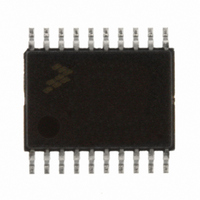MC9S08EL16CTJ Freescale Semiconductor, MC9S08EL16CTJ Datasheet - Page 227

MC9S08EL16CTJ
Manufacturer Part Number
MC9S08EL16CTJ
Description
MCU 16KB FLASH SLIC 20TSSOP
Manufacturer
Freescale Semiconductor
Series
HCS08r
Datasheet
1.DEMO9S08EL32.pdf
(356 pages)
Specifications of MC9S08EL16CTJ
Core Processor
HCS08
Core Size
8-Bit
Speed
40MHz
Connectivity
I²C, LIN, SCI, SPI
Peripherals
LVD, POR, PWM, WDT
Number Of I /o
16
Program Memory Size
16KB (16K x 8)
Program Memory Type
FLASH
Eeprom Size
512 x 8
Ram Size
1K x 8
Voltage - Supply (vcc/vdd)
2.7 V ~ 5.5 V
Data Converters
A/D 12x10b
Oscillator Type
External
Operating Temperature
-40°C ~ 85°C
Package / Case
20-TSSOP
Processor Series
S08EL
Core
HCS08
Data Bus Width
8 bit
Data Ram Size
1 KB
Interface Type
SCI, SPI, I2C, SLIC
Maximum Clock Frequency
200 KHz
Number Of Programmable I/os
16
Number Of Timers
2
Operating Supply Voltage
5.5 V
Maximum Operating Temperature
+ 85 C
Mounting Style
SMD/SMT
3rd Party Development Tools
EWS08
Development Tools By Supplier
DEMO9S08EL32AUTO, DEMO9S08EL32
Minimum Operating Temperature
- 40 C
On-chip Adc
10 bit, 12 Channel
For Use With
DEMO9S08EL32 - BOARD DEMO FOR 9S08 EL MCUDEMO9S08EL32AUTO - DEMO BOARD EL32 AUTO
Lead Free Status / RoHS Status
Lead free / RoHS Compliant
- Current page: 227 of 356
- Download datasheet (9Mb)
SLCACT will only be cleared by the SLIC upon successful completion of a normal LIN message frame
(see
with an error condition or some source other than those cited in the SLCACT bit description, SLCACT
might remain set during an otherwise idle bus time. SLCACT will then clear upon the successful
completion of the next LIN message frame.
These mechanisms might result in SLCACT being set when it is safe (from the SLIC module perspective)
to trim the oscillator. However, SLCACT will only be clear when the SLIC considers it safe to trim the
oscillator.
In a particular system, it might also be possible to improve the opportunities for trimming by using system
knowledge and use of IMSG. If a message ID is known to be considered a “don’t care” by this particular
node, it should be safe to trim the oscillator during that message frame (provided that it is safe for the
application software as well). After the software has done an identifier lookup and determined that the ID
corresponds to a “don’t care” message, the software might choose to set IMSG. From that time, the
application software should have at least one byte time of message traffic in which to trim the oscillator
before that ignored message frame expires, regardless of the state of SLCACT. If the length of that ignored
message frame is known, that knowledge might also be used to extend the time of this oscillator trimming
opportunity.
Now that the mechanisms for recognizing when the SLIC module indicates safe oscillator trimming
opportunities are understood, it is important to understand how to derive the information needed to
perform the trimming.
The value in SLCBT will indicate how many SLIC clock cycles comprise one bit time and for any given
LIN bus speed, this will be a fixed value if the oscillator is running at its ideal frequency. It is possible to
use this ideal value combined with the measured value in SLCBT to determine how to adjust the oscillator
of the microcontroller.
The actual oscillator trimming algorithm is very specific to each particular implementation, and
applications might or might not require the oscillator even to be trimmed. The SLIC can maintain
communications even with input oscillator variation of ±50% (with 4 MHz nominal, that means that any
input clock into the SLIC from 2 MHz to 6 MHz will still guarantee communications). Because Freescale
internal oscillators are at least within ±25% of their nominal value, even when untrimmed, this means that
trimming of the oscillator is not even required for LIN communications. If the application can tolerate the
range of frequencies which might appear within this manufacturing range, then it is not necessary ever to
trim the oscillator. This can be a tremendous advantage to the customer, enabling migration to very
low-cost ROM devices which have no non-volatile memory in which to store the trim value.
Freescale Semiconductor
Section ,
“,” description for more detail). This means that in some cases, if a message frame terminates
Even though most internal oscillators are within ±25% before trimming,
they are stable at some frequency in that range, within at least ±5% over the
entire operating voltage and temperature range. The trimming operation
simply eliminates the offset due to factory manufacturing variations to
re-center the base oscillator frequency to the nominal value. Please refer to
the electrical specifications for the oscillator for more specific information,
as exact specifications might differ from module to module.
MC9S08EL32 Series and MC9S08SL16 Series Data Sheet, Rev. 3
NOTE
229
Related parts for MC9S08EL16CTJ
Image
Part Number
Description
Manufacturer
Datasheet
Request
R
Part Number:
Description:
Manufacturer:
Freescale Semiconductor, Inc
Datasheet:
Part Number:
Description:
Manufacturer:
Freescale Semiconductor, Inc
Datasheet:
Part Number:
Description:
Manufacturer:
Freescale Semiconductor, Inc
Datasheet:
Part Number:
Description:
Manufacturer:
Freescale Semiconductor, Inc
Datasheet:
Part Number:
Description:
Manufacturer:
Freescale Semiconductor, Inc
Datasheet:
Part Number:
Description:
Manufacturer:
Freescale Semiconductor, Inc
Datasheet:
Part Number:
Description:
Manufacturer:
Freescale Semiconductor, Inc
Datasheet:
Part Number:
Description:
Manufacturer:
Freescale Semiconductor, Inc
Datasheet:
Part Number:
Description:
Manufacturer:
Freescale Semiconductor, Inc
Datasheet:
Part Number:
Description:
Manufacturer:
Freescale Semiconductor, Inc
Datasheet:
Part Number:
Description:
Manufacturer:
Freescale Semiconductor, Inc
Datasheet:
Part Number:
Description:
Manufacturer:
Freescale Semiconductor, Inc
Datasheet:
Part Number:
Description:
Manufacturer:
Freescale Semiconductor, Inc
Datasheet:
Part Number:
Description:
Manufacturer:
Freescale Semiconductor, Inc
Datasheet:
Part Number:
Description:
Manufacturer:
Freescale Semiconductor, Inc
Datasheet:










